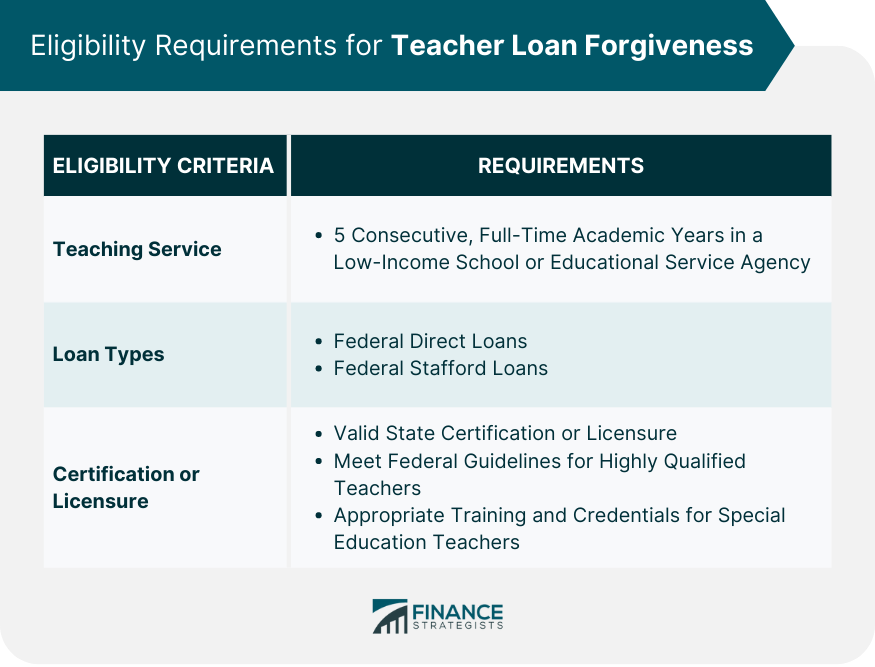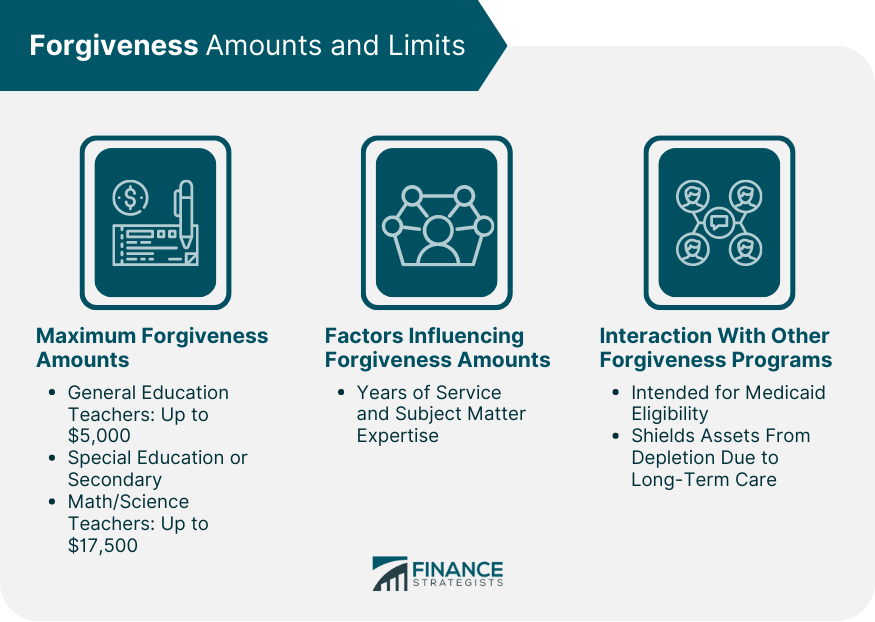Teacher Loan Forgiveness is a federal program designed to alleviate the burden of student loan debt for educators who work in low-income schools or educational service agencies. The program recognizes the vital role teachers play in shaping the future and aims to encourage qualified individuals to pursue teaching careers, especially in underserved areas. The Teacher Loan Forgiveness program was established in 1998 as part of the Higher Education Amendments. The program has since undergone several revisions, expanding its scope and modifying eligibility requirements to better serve the teaching profession and education sector. Since its inception, the Teacher Loan Forgiveness program has evolved to better address the needs of educators and schools. Changes have been made to the eligibility criteria, loan types covered, and the forgiveness amounts offered. Teacher Loan Forgiveness has played a significant role in incentivizing qualified professionals to pursue careers in education, particularly in low-income areas. By reducing the financial burden of student loan debt, the program has helped attract and retain talented educators, ultimately benefiting students and the overall education sector. To qualify for loan forgiveness, teachers must complete a minimum of five consecutive, full-time academic years of service at a low-income school or educational service agency. Teachers must complete the required five years of service without interruption, except for qualifying reasons such as family or medical leave. Eligible schools and educational service agencies are those identified by the Department of Education as having a high percentage of students from low-income families. The following loan types are eligible for forgiveness under the Teacher Loan Forgiveness program: 1. Federal Direct Loans (Subsidized and Unsubsidized) 2. Federal Stafford Loans (Subsidized and Unsubsidized) 3. Federal Perkins Loans (Discontinued Program) To be eligible for loan forgiveness, teachers must meet certain qualifications: 1. Possess a valid certification or licensure in their state 2. Be considered a highly qualified teacher under federal guidelines 3. Special education teachers must have appropriate training and credentials To apply for loan forgiveness, teachers must complete and submit the Teacher Loan Forgiveness Application, along with any required supporting documentation, such as proof of employment and certification. There is no specific deadline for submitting a Teacher Loan Forgiveness application. However, it is recommended that teachers apply as soon as they have completed the required five years of service. Common mistakes include incomplete or inaccurate information, missing documentation, and failure to meet eligibility requirements. To increase the chances of a successful application, teachers should thoroughly review all requirements, gather necessary documentation, and double-check their application for accuracy before submission. The maximum forgiveness amounts depend on the teacher's role and subject matter expertise: 1. General education teachers: up to $5,000 2. Special education teachers or secondary math/science teachers: up to $17,500 The actual forgiveness amount a teacher receives depends on various factors, including years of service and subject matter expertise. Teachers may be eligible for additional forgiveness programs, such as Public Service Loan Forgiveness. However, they cannot receive benefits from both programs simultaneously for the same period of service. Teacher Loan Forgiveness is generally not considered taxable income by the IRS. However, tax laws may change, and teachers should consult a tax professional for the most up-to-date information. Teachers should keep accurate records of their loan forgiveness, including the amount forgiven and any correspondence with their loan servicer, in case they need to provide documentation to the IRS or other tax authorities. Tax laws are subject to change, and it is essential for teachers to stay informed about any revisions that may impact the taxability of their forgiven loans. Consulting with a tax professional or monitoring updates from the IRS can help ensure compliance with current tax laws. Some critics argue that the Teacher Loan Forgiveness program disproportionately benefits certain groups of teachers, such as those in specialized fields or with higher levels of education. Additionally, the program may be inaccessible to some teachers due to complex eligibility requirements and application processes. While the program aims to increase teacher retention in low-income schools, some argue that it does not adequately address other factors contributing to high turnover rates, such as low salaries, challenging work conditions, and lack of support. Proposals for improving the Teacher Loan Forgiveness program include simplifying the application process, expanding eligibility requirements, increasing forgiveness amounts, and addressing other factors impacting teacher retention and satisfaction. Teacher Loan Forgiveness has played an essential role in attracting and retaining talented educators, especially in low-income areas. By reducing the financial burden of student loan debt, the program has made it possible for more individuals to pursue and remain in the teaching profession. As the program continues to evolve, it is crucial to address its shortcomings and ensure that it effectively supports teachers and the education sector as a whole. Future prospects for the program may include potential changes to eligibility requirements, forgiveness amounts, and the application process. Teachers who qualify for loan forgiveness are encouraged to take advantage of the program, as it can significantly alleviate the burden of student loan debt and contribute to their financial well-being.Teacher Loan Forgiveness Overview
History of Teacher Loan Forgiveness
Origins and Legislative Background
Evolution of the Program Over Time
Impact on the Teaching Profession and Education Sector
Eligibility Requirements for Teacher Loan Forgiveness

Teaching Service Requirements
Years of Service
Low-Income Schools or Educational Service Agencies
Loan Types Eligible for Forgiveness
Teacher Qualifications
Application Process for Teacher Loan Forgiveness
Necessary Forms and Documents
Submission Timeline and Deadlines
Common Mistakes and Tips for a Successful Application
Forgiveness Amounts and Limits

Maximum Forgiveness Amounts
Factors Influencing Forgiveness Amounts
Interaction with Other Forgiveness Programs
Tax Implications of Teacher Loan Forgiveness
Taxability of Forgiven Loans
Proper Documentation for Tax Purposes
Potential Changes to Tax Laws
Criticisms and Controversies Surrounding Teacher Loan Forgiveness
Fairness and Accessibility Concerns
Impact on Teacher Retention
Suggestions for Improvement
Conclusion
Teacher Loan Forgiveness FAQs
Teacher Loan Forgiveness is a federal program that helps reduce the burden of student loan debt for eligible educators who work in low-income schools or educational service agencies. To be eligible, teachers must complete at least five consecutive, full-time academic years of service, hold a valid certification or licensure, and meet other specific qualifications.
The maximum forgiveness amount depends on a teacher's role and subject matter expertise. General education teachers can receive up to $5,000 in loan forgiveness, while special education teachers or secondary math/science teachers can receive up to $17,500.
Eligible loan types for Teacher Loan Forgiveness include Federal Direct Loans (Subsidized and Unsubsidized), Federal Stafford Loans (Subsidized and Unsubsidized), and Federal Perkins Loans (discontinued program).
Teacher Loan Forgiveness is generally not considered taxable income by the IRS. However, tax laws may change, so it is essential for teachers to consult a tax professional for the most up-to-date information.
To apply for Teacher Loan Forgiveness, you must complete and submit the Teacher Loan Forgiveness Application, along with any required supporting documentation, such as proof of employment and certification. To increase your chances of a successful application, make sure to thoroughly review all eligibility requirements, gather the necessary documentation, and double-check your application for accuracy before submission.
True Tamplin is a published author, public speaker, CEO of UpDigital, and founder of Finance Strategists.
True is a Certified Educator in Personal Finance (CEPF®), author of The Handy Financial Ratios Guide, a member of the Society for Advancing Business Editing and Writing, contributes to his financial education site, Finance Strategists, and has spoken to various financial communities such as the CFA Institute, as well as university students like his Alma mater, Biola University, where he received a bachelor of science in business and data analytics.
To learn more about True, visit his personal website or view his author profiles on Amazon, Nasdaq and Forbes.











